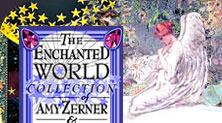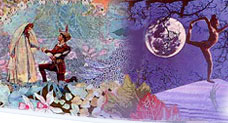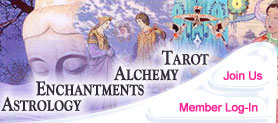 |
About Us


The HERstory of the Goddess
Women have gotten the short end of the stick for too long and our book/oracle "Goddess,
Guide Me!" is about women reclaiming their birthright. Here's an excerpt
from its accompanying book, "The Herstory of the Goddess."

Goddess,
Guide Me! is a rediscovery of the ancient connection between the
worship of the Goddess and the art of divination. The worship of either
the Great Mother Goddess or God the Father and the desire to predict the
future are as inseparable today as they were when woman first conceived
of a Supreme Creative Force. The Judeo-Christian Bible is based on
prophecies and their fulfillment; Mohammed is also known as the Prophet;
and the immense population of China has the philosophies of
Confucianism and Taoism as the foundation for their ethical and legal
systems, both of which are based on the I Ching, or Book of Changes, the
oldest oracle system known.
The conception of a male Supreme Being
found in these and other patriarchal religions so permeates nearly every
aspect of present-day culture that it is easy to assume that things
have existed this way since the dawn of time. Yet there is growing
evidence that the concept of the Supreme Being as a male is a relatively
recent development.
To understand the herstory of the Goddess we must return to an earlier time, when God was a woman.
Our
distant ancestors lived in a world more dangerous and stressful than we
can imagine. Fierce animals threatened them every day. They were
completely dependent on the forces of nature for their survival. Our
species was able to survive and prosper not only because of growing
intellectual abilities but because we were able to grow emotionally as
well. To do this, our ancestors needed desperately to feel a bit of the
security they had felt as children in their mothers' arms. Life would
have appeared meaningless and hopeless without it.
Their daily
connection to the cycle of birth, life, and death suggested that there
was a force that had given birth to the Heavens and to the Earth and all
who lived upon it. They wanted to communicate with this force and
obtain its protection and guidance.
It was obvious that life issued
forth only from the female of every species. Logic as well as growing
historical evidence indicates that when people first prayed to the
Supreme Being who had created their world, they worshipped her as the
Goddess, Mother of All Things.
The earliest carved image found thus
far, known as the Venus of Willendorf, is thought to be a devotional
statue of the Goddess. This small stone figure is of a pregnant woman
with large, nurturing breasts and, like many ancient images of the
Goddess, no feet.
The Goddess's pregnant form symbolized the
fertility our ancestors needed in the form of children, a plentiful
supply of the animals they depended on for food, and the fertility of
the Earth (which gave them edible plants, water, and shelter from the
elements). The Goddess's missing feet are thought to be symbolic of her
inseparable connection to the Earth.
It is not hard to imagine our
ancestors creating these devotional art objects as a means of
establishing a personal connection with the immense, unpredictable
forces that so dominated their lives. They must have prayed for the
ability to predict the change of the seasons and the return of the
migrating herds so that their survival might better be ensured.
Their
prayers were literally answered by the Moon. Unlike the unchanging Sun,
the Moon changed shape every night. The first conception of time came
with the realization that there was a predictable pattern to these
changes. Every twenty-eight days the Moon changed from being completely
absent to being completely full. Every thirteen moons,or months, as we
now call them,the herds returned from their migrations, and every three
months and seven days the seasons could be expected to change. It was no
wonder that the Moon, as the creator of time itself, was glorified
throughout the ancient world as the symbol of the Goddess-the Creator,
Preserver, and Destroyer of Life,while the Sun was universally regarded
as her consort and child.
The waxing Moon was seen as a slender
maiden, a young huntress with a curved bow. The full Moon was viewed as a
rounded, pregnant woman, mature and full at the moment of her greatest
capacity to give life. The waning Moon was seen as an older woman,
mysterious and wise, bearing knowledge of the death that was to come in
the blackness of the new Moon and the reincarnation that would
inevitably follow.
The already exalted nature of the childbearing
female of our species was greatly amplified when it was first realized
that a woman's magical menstrual blood began to flow every
twenty-eight days, the same period as the Moon's cycle.
Women were
held sacred (from the Latin sacer, meaning "untouchable"), as nothing
less than living symbols of the Goddess. Women enjoyed a privileged
status that enabled them to make many discoveries from their observation
of the natural world. It is thought that pottery, herbal medicine,
agriculture, the domestication of animals, astrology, and even religion
itself may have been the discovery and the exclusive province of women.
Tribes and clans were ruled by matriarchs in families and societies
whose gender-based roles and customs bore little resemblance to those we
take for granted today.
(c) Monte Farber Brigit tapestry (c) Amy Zerner
Goddess, Guide Me! is available in our web store.
|
|
|
  |
|
 |









